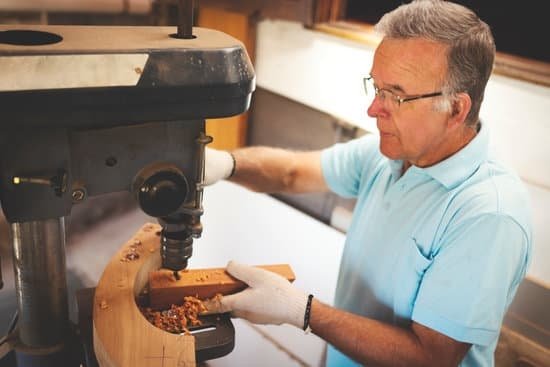Woodworking is a versatile and creative craft that requires precision, skill, and the right materials to produce high-quality results. One important aspect of woodworking is sealing, which helps protect the wood from moisture, wear and tear, and enhances its overall durability.
When it comes to sealing wood, one popular option is epoxy. In this article, we will delve into whether epoxy is a good seal for woodworking and explore its benefits, drawbacks, as well as compare it to other sealing options.
Before diving into the specifics of epoxy as a sealing agent for woodworking projects, it is crucial to understand the basics. Epoxy is a type of synthetic resin made by combining a resin with a hardener. It creates a strong bond when cured, making it an excellent choice for various applications, including woodworking.
However, it’s essential to note that there are other options available for sealing wood, such as oil-based finishes or polyurethane. Each option has its advantages and disadvantages, but epoxy has gained popularity due to its durability and protective qualities.
When used as a sealant for woodworking projects, epoxy provides many benefits. Its most notable advantage is its exceptional durability; once cured, epoxy forms a hard and resilient surface that can withstand heavy use and resist moisture penetration effectively. Furthermore, epoxy creates a protective barrier against scratches and UV rays while enhancing the natural beauty of the wood grain. However, like any material or technique in woodworking, there are potential drawbacks and limitations associated with using epoxy as well.
In the following sections of this article, we will dive deeper into how epoxy works as a sealant for woodworking projects compared to other options available in the market. We will examine its pros and cons thoroughly so that you can make an informed decision when choosing the most suitable material for your next project.
Additionally, we will provide tips on using epoxy effectively as a sealant in woodworking projects based on best practices and techniques used by professionals in the field. So, let’s explore the fascinating world of epoxy as a seal for woodworking and determine if it truly is a good option to enhance the beauty and longevity of your wood creations.
What is Epoxy and How Does It Work as a Sealant for Woodworking?
Epoxy is a versatile and strong adhesive that has gained popularity among woodworkers as a sealant for various woodworking projects. In this section, we will explore the characteristics of epoxy and delve into how it works as a sealant for woodworking.
The Basics of Epoxy
Epoxy is a two-part adhesive system consisting of resin and hardeners. When these two components are mixed together, they undergo a chemical reaction that results in a strong and durable bond. It is important to note that not all epoxy formulations are suitable for use as sealants in woodworking. Therefore, it is crucial to choose an epoxy specifically designed for woodworking applications.
How Epoxy Works as a Sealant
Epoxy works as a sealant for woodworking by creating a protective barrier on the surface of the wood. When applied correctly, epoxy penetrates the wood fibers and fills any porous areas or gaps, preventing moisture or other contaminants from seeping into the wood. The curing process of epoxy ensures an exceptionally strong bond between the wood and the epoxy itself, providing additional structural support to the project.
Moreover, epoxy has excellent resistance to water, chemicals, and UV rays, making it an ideal choice for outdoor wooden furniture or structures that are exposed to harsh environmental conditions. Its high strength properties also make it suitable for sealing wooden objects subjected to heavy wear and tear such as tabletops or countertops.
Overall, epoxy acts as both a sealant and adhesive in woodworking projects by protecting the wood from damage caused by moisture while strengthening its structure.
In the next section, we will explore the benefits associated with using epoxy as a sealant in woodworking projects.
Benefits of Using Epoxy as a Woodworking Sealant
Epoxy is a popular choice for woodworking sealants due to its numerous benefits in terms of durability and protection. When used as a sealant, epoxy forms a strong and resilient barrier that helps to protect wood from various factors such as moisture, UV rays, and general wear and tear.
One of the key advantages of using epoxy as a woodworking sealant is its exceptional durability. Epoxy has high mechanical strength and adhesion properties, which means it can withstand heavy use and resist cracking or peeling over time. This makes it ideal for sealing wooden objects or surfaces that are exposed to frequent handling or potential damage, such as tabletops, cutting boards, or outdoor furniture.
Additionally, epoxy provides excellent protection against moisture. Wood is susceptible to warping, rotting, and swelling when exposed to water or humid environments. However, when properly sealed with epoxy, the wood becomes waterproof and less prone to these issues. Epoxy creates a watertight barrier that prevents water molecules from penetrating the wood fibers, ensuring its longevity and structural integrity.
Another benefit of using epoxy as a woodworking sealant is its ability to shield wood from harmful UV rays. Over time, direct sunlight can cause wood to fade, discolor, and deteriorate. By applying an epoxy sealant with UV inhibitors or by top-coating with an additional protective layer containing UV absorbers or blocking agents, the wood can be shielded from UV damage and maintain its original color and appearance for longer periods.
Potential Drawbacks of Using Epoxy as a Woodworking Sealant
When considering epoxy as a sealant for woodworking, it is important to understand the potential drawbacks that come along with its use. While epoxy can be a durable and effective option for sealing wood, there are certain considerations and limitations that should be taken into account.
One potential drawback of using epoxy as a woodworking sealant is the difficulty in achieving a completely smooth finish. Epoxy has a tendency to self-level and can leave behind uneven surfaces or visible brush strokes. This can be especially problematic when working on projects that require a flawless finish, such as tabletops or high-end furniture pieces. While sanding and polishing can help to improve the surface, it may not always result in the desired level of smoothness.
Another limitation of epoxy as a woodworking sealant is its sensitivity to UV light. Over time, exposure to sunlight can cause epoxy to yellow or become discolored. This can be an issue for projects that will be exposed to direct sunlight or have light-colored woodwork. To mitigate this drawback, it is important to choose an epoxy that has UV inhibitors or apply a protective topcoat over the epoxy layer.
Additionally, working with epoxy requires careful attention to safety precautions. Epoxy resin and hardener emit strong fumes during the curing process, which can be harmful if inhaled in large quantities. It is essential to work in a well-ventilated area and wear appropriate personal protective equipment, such as gloves and goggles when handling epoxy.
Comparing Epoxy to Other Woodworking Sealants
Pros of Using Epoxy as a Woodworking Sealant
Epoxy offers several advantages over other types of woodworking sealants. One major benefit is its exceptional durability. Epoxy is known for its strong and resilient nature, making it an ideal choice for sealing wood surfaces that are exposed to harsh conditions or heavy use. It can withstand moisture, heat, UV rays, and chemicals without degrading or losing its protective properties.
Another advantage of using epoxy as a woodworking sealant is its excellent adhesion to wood. When properly applied, epoxy forms a strong bond with the wood fibers, creating a tight barrier that prevents moisture or other substances from penetrating the surface. This level of adhesion also helps to strengthen the wood and prevent cracking or splitting over time.
Additionally, epoxy provides a clear, glossy finish that enhances the natural beauty of the wood grain. It can be sanded and polished to achieve a smooth and professional-looking surface. This makes epoxy an appealing choice for projects where aesthetics are important, such as furniture or decorative items.
Cons of Using Epoxy as a Woodworking Sealant
While epoxy has many advantages, there are also some drawbacks to consider when using it as a woodworking sealant. One limitation is its relatively high cost compared to other sealants. Epoxy can be more expensive than alternative options, especially if large quantities are needed for big projects.
Another potential drawback is the curing time required for epoxy. Unlike some fast-drying sealants, epoxy typically takes several hours or even days to fully cure and harden. This means that you may need to factor in additional waiting time before proceeding with further work on your project.
Furthermore, while epoxy has excellent adhesion properties, it may not adhere well to certain types of woods that have high oil content or natural oils present in their composition. In these cases, it is important to properly prepare the wood surface and select an epoxy specifically designed for use on oily woods.
Comparison to Other Woodworking Sealants
When comparing epoxy to other woodworking sealants, it is important to consider the specific needs of your project. Varnishes, for example, are a popular choice for sealing wood surfaces due to their ease of use and wide availability.
They offer some level of protection against moisture and mild wear, but may not provide the same level of durability and resistance as epoxy. Polyurethane sealants are also commonly used in woodworking and can offer good protection, but they may not adhere as well to certain woods.
Ultimately, each type of sealant has its own pros and cons, and the best choice will depend on the specific requirements of your project. Consider factors such as durability, adhesion strength, cost, and curing time when deciding which sealant is most suitable for your woodworking needs.
Tips for Using Epoxy as a Woodworking Sealant
When using epoxy as a sealant for woodworking projects, there are certain best practices and techniques that can ensure successful results. Here are some tips to help you make the most out of your epoxy sealant:
- Prepare the wood surface: Before applying epoxy, it is crucial to properly prepare the wood surface. This involves sanding the wood to a smooth finish and removing any dust or debris. Additionally, it is important to make sure the wood is dry and free from moisture, as epoxy may not adhere well to damp surfaces.
- Mix the epoxy correctly: Epoxy typically comes in two parts – resin and hardener – which need to be mixed together in order for the sealant to cure properly. It is essential to carefully follow the manufacturer’s instructions on proportions and mixing times. Use a clean container and stir the mixture thoroughly until it becomes homogenous.
- Apply multiple thin coats: When applying epoxy as a sealant, it is advisable to apply multiple thin coats rather than one thick coat. This helps prevent drips, bubbles, and uneven coverage. Allow each coat to fully cure before applying the next one, following the recommended curing time provided by the manufacturer.
- Use proper ventilation: Epoxy can emit strong fumes during application and curing process. It is important to work in a well-ventilated area or wear appropriate respiratory protection if necessary. Ventilation not only helps dissipate fumes but also aids in achieving better curing results.
- Prevent air bubbles: Air bubbles can often mar the finish of an epoxy-sealed woodworking project. To minimize air bubbles, you can use a heat gun or blowtorch on low setting after pouring epoxy onto your project surface. The gentle heat will help pop any bubbles that may have formed during application.
- Take safety precautions: Working with epoxy requires caution, so it is crucial to take necessary safety precautions. Wear protective gloves and goggles to protect your skin and eyes from potential irritants. Avoid contact with epoxy on bare skin and clean any spills or drips immediately.
By following these best practices and techniques, you can ensure that epoxy is used effectively as a woodworking sealant. Remember to always read and adhere to the instructions provided by the manufacturer for the specific epoxy product you are using. With proper care and attention, epoxy can provide a durable and protective seal for your woodworking projects.
Case Studies
In this section, we will explore some real-life examples of how epoxy has been used as a woodworking sealant. These case studies will provide insights into the effectiveness and practical applications of using epoxy in various woodworking projects.
Example 1: Tabletop Restoration
One common use of epoxy in woodworking is for table or countertop restoration. In a case study where an old wooden tabletop was in need of repair, epoxy was successfully utilized to fill in cracks and imperfections, as well as to provide a durable and glossy finish.
The epoxy not only strengthened the wood but also added a smooth and level surface, making the table look like new again. This example highlights the versatility of epoxy as both a filler and sealer for woodworking projects.
Example 2: Outdoor Furniture Protection
Outdoor furniture is exposed to harsh weather conditions that can cause damage and deterioration over time. In another case study, epoxy was applied to outdoor wooden furniture to protect it from moisture, UV rays, and general wear and tear. The epoxy acted as a barrier against water penetration and prevented any further damage to the wood. This case study illustrates how epoxy can enhance the longevity of wooden furniture by providing long-lasting protection even in challenging environments.
Example 3: Artistic Woodworking Creations
Epoxy is not just limited to repairing and protecting wood; it can also be incorporated into artistic woodworking creations. In one particular case study, an artist used epoxy resin to create mesmerizing river tables by embedding colored pigments into the resin.
The result was stunning pieces of furniture with unique patterns that showcased the natural beauty of wood combined with the creative possibilities offered by epoxy. This example demonstrates how epoxy can be utilized beyond traditional sealing purposes to add aesthetic value to woodworking projects.
These case studies highlight the diverse applications of using epoxy as a sealant in woodworking projects. From restoring old furniture to protecting outdoor pieces and creating artistic designs, epoxy offers durability, protection, and aesthetic enhancement. However, it is important to consider the limitations and potential drawbacks of using epoxy as well, which will be discussed in the next section.
| Case Study | Description |
|---|---|
| Tabletop Restoration | Epoxy used to fill cracks, provide a level surface, and add a glossy finish to an old wooden table. |
| Outdoor Furniture Protection | Epoxy applied to outdoor wooden furniture to protect it from moisture, UV rays, and general wear and tear. |
| Artistic Woodworking Creations | Epoxy resin used creatively to embed colored pigments into the resin for unique artistic river tables. |
Q&A
As epoxy is becoming more popular in the woodworking community, it’s natural to have some questions and concerns about its use as a sealant. In this section, we will address some common queries and provide answers to help you make an informed decision.
Can epoxy be used on all types of wood?
While epoxy can generally be used on most types of wood, there are some considerations to keep in mind. Some woods naturally contain oils or high levels of acidity that can interfere with adhesion. It’s important to check if the type of wood you’re working with is compatible with epoxy by doing a small test application first.
Is epoxy safe to use in food contact surfaces?
Not all epoxy formulations are suitable for direct food contact. However, there are food-safe epoxies available on the market that have been specifically designed for use on cutting boards, countertops, and other food-related applications. These epoxies are non-toxic once fully cured and provide a durable and waterproof seal.
How long does it take for epoxy to cure?
The curing time for epoxy can vary depending on several factors such as temperature, humidity, and the specific product being used. Generally, most epoxies will reach their full cure within 24-72 hours. However, it is important to read the manufacturer’s instructions carefully as they will provide specific guidelines on curing times for optimal results.
| Question | Answer |
|---|---|
| 1. Can epoxy be used on all types of wood? | While epoxy can generally be used on most types of wood, some woods may contain oils or high levels of acidity that could interfere with adhesion. |
| 2. Is epoxy safe to use in food contact surfaces? | Not all epoxies are suitable for direct food contact, but there are food-safe options available specifically designed for such applications. |
| 3. How long does it take for epoxy to cure? | The curing time for epoxy varies but is typically within 24-72 hours. It is important to follow the manufacturer’s instructions for specific guidelines. |
By addressing these common questions and concerns, we hope to provide you with a clearer understanding of using epoxy as a woodworking sealant and help you make well-informed decisions in your projects. Remember to always refer to the manufacturer’s instructions and conduct proper testing before applying epoxy to your woodwork.
Conclusion
In conclusion, epoxy can be a good sealant for woodworking projects due to its durability and protective properties. It forms a strong bond with the wood, creating a long-lasting barrier against moisture, stains, and damage. Epoxy also provides a smooth and glossy finish that enhances the overall appearance of the woodwork.
Despite its benefits, there are some potential drawbacks to using epoxy as a woodworking sealant that should be considered. One limitation is that it can be time-consuming and require precise application techniques to achieve optimal results. Additionally, epoxy may not be suitable for all types of woodworking projects or wood species, as some woods may not bond well with epoxy or may react unfavorably.
When comparing epoxy to other woodworking sealants, it is important to weigh the pros and cons based on individual project needs. While epoxy offers excellent protection and durability, other options such as varnishes or oils may provide different aesthetics or ease of application depending on the desired outcome.
In addition to considering these factors, following best practices and techniques when using epoxy as a woodworking sealant will help ensure successful results. This includes properly preparing the wood surface, mixing and applying the epoxy accurately, and allowing sufficient curing time for optimal adhesion.
Ultimately, whether epoxy is a good sealant for woodworking depends on the specific project requirements and personal preferences. It is recommended to conduct thorough research, consult with professionals if needed, and test on small areas before committing to epoxy as a primary sealant. With proper understanding and application techniques, epoxy can indeed be an effective choice for sealing woodworking projects.

Hi everyone! I’m a woodworker and blogger, and this is my woodworking blog. In my blog, I share tips and tricks for woodworkers of all skill levels, as well as project ideas that you can try yourself.





